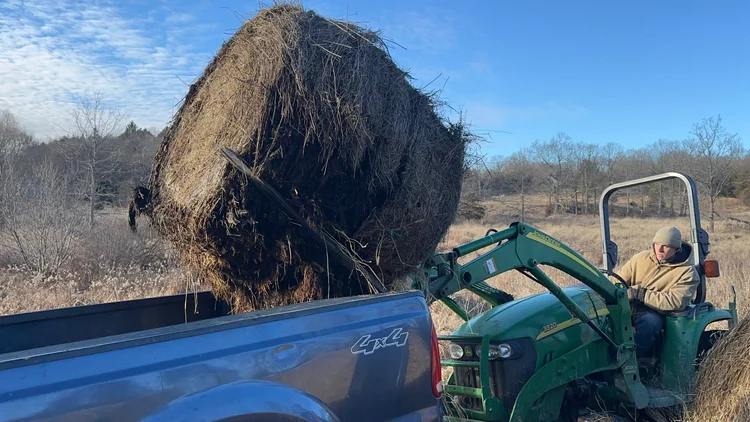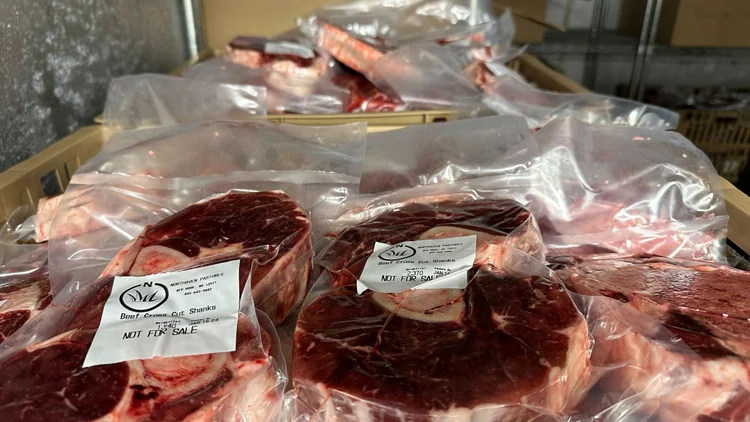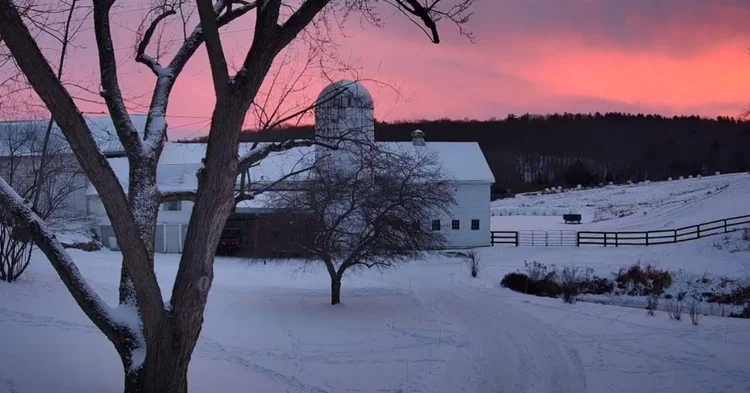Your basket is empty
Already have an account? Log in to check out faster.
Already have an account? Log in to check out faster.

On August 20th of 2021, a local dairy farmer grabbed his mail on the way inside for breakfast after turning his herd back out to graze fresh pasture until the evening milking time. It was another challenging year with high rainfall and small windows of dryness to get out in the fields and make hay for his winter feed, but at least there was plenty of grass for the cows to eat. As he awaited his meal he found what he thought would be his annual renewal contract with his milk purchaser, Horizon Organic Dairy. Except this year, it wasn’t a renewal at all. Upon opening the envelope it read, “NOTICE CONTRACT TERMINATION”. The letter informed him that by August of 2022 Horizon would no longer be purchasing milk from his, or any of the other small organic dairy farms between the states of New York and Maine.
Horizon was moving all of its organic milk to the desert. Yes, the dairy desert. These 89 small dairies milking 200 cows or less, were being replaced by one 10,000 cow dairy in the desert, where all the feed would have to be trucked in from far away or made on heavily irrigated cropland while cows stayed inside. Their reason being that you can easily confine an animal and keep them disease free (not to be confused with healthy) in an arid climate without antibiotics. If you did that in our Northeast climate you’d have a parasite-ridden, dead cow in a few months. This enables organic to be conducted at the same “efficiency” and scale as conventional dairy while getting the premium price that the organic seal provides. It’s something that all the largest players in cooperate dairy want a piece of.
The organic standards for livestock are actually quite good, I would say. If one takes the time to read through them, it sounds a lot like the farming we conduct here on our farm. However, the downfall of the movement was not the definition, it was scale. The farming economy saw an opportunity it could not pass up. The premium price and the ever increasing demand for the label is what initiated the erosion of the ethics behind organic. The narratives that are told around food lose their meanings as corporations capture them, regardless of how well the standards are formed and how good the narrative is. There always seems to be a way to tell the story people want to hear without walking the walk.
Organic, being the only agricultural buzzword with a formal legal definition, has lost its trust. With examples such as Horizon, the organic seal has proven itself to mean what it say it means, but in the least possible fashion. They are just words. It’s no wonder that farmers initiated a new movement to once again separate themselves from the status quo. Beginning in the late 1980’s but become ignited with incredible vigor and popularity in 2020, was the Regenerative Farming movement.

Everyone seems to care about it suddenly, from the health influencers on social media to Kellogg’s. The concepts of soil health, carbon sequestration and land regeneration are making headlines in NY Timesand the World Economic Forum. It’s the new “organic”. The cutting edge way to move forward with food production is now regenerative.
The word regenerative was first used by Robert Rodale as he was beginning his research in the 1980’s. He was an innovator in the organic farming space and wanted to distinguish good organic stewardship from the organic that only followed the do-nots and nothing more. He defined "regenerative organic" as a holistic approach to farming that encourages continuous innovation and improvement of environmental, social, and economic measures.
But just as it is with being “super”, once everyone is regenerative, no one is. Besides, I’m not sure we can agree on what regenerative even means. Upon perusing the websites of the large, ultra-processed food companies that are claiming the same ethos as our farm, one can gather their definition of regenerative, which seems to mean adding an annual cover crop between wheat and corn plantings in the summers. That cover crop is then Roundup-ed and the next planting of “bioengineered” grain follows (Notice the stigma around GMO caught on, and now bioengineered is the new word. Which, to their credit, does sound smarter.)
Now, I’m glad that the 250,000 acres of conventional wheat farmed for Kellogg’s is being cover-cropped. I am not glad that it has created a need for another round of herbicides, which ultimately end up in the waterways and the guts of the American people. Yet if what we do and what they do is the labeled the same thing, then I think we need some more specific terms.

There is a tendency in the regenerative movement to over emphasize how smart we are. The feeling of newness that’s portrayed in many of the documentaries and books is positive on the level of excitement over good food and farming, but at the end of the day there truly is “nothing new under the sun.” Frequent livestock rotation, building soil and sequestering carbon have always been staples of organic farming (and what was simply know as just farming pre-WWII).
Many of the popular voices in the real food movement discuss the “magic” of animals and the “healing” that they induce to the environments they inhabit. While there’s truth to them, explaining these concepts to someone who has been around agriculture for a while is a lot like bragging about understanding basic multiplication to someone studying complex calculus. Though the profoundness of these incredible systems imbedded in design cannot be understated, we didn’t invent anything. Just rediscovered.
The Earth is simply on a weight gain program. Building is its natural status— it is the basic process of photosynthesis. All we have to do is not destroy it and it naturally builds. In a situation where our involvement has induced a deficit, I suppose reintroducing this process is now regenerative.
It doesn’t take the brightest of minds and the endless documentaries on regenerative farming for someone to watch as we dispose massive amounts manure into rivers and oceans, only to fertilize the fields that feed the animals that produced the manure with petroleum based fertilizers that we mined from the ground, and wonder if maybe we should just use those nutrients that we just polluted the river with instead.
The crux of regenerative farming is simply nutrient cycling and maximizing photosynthesis. All the other vital parts of our style of farming can actually come through that. Good nutrient cycling requires robust microbial health in the soil, which can very easily be interrupted.

I once managed a farm that historically used Ivermectin to de-worm the cattle on a regular basis. When I first walked the fields, I was astonished to find that this (seemingly mild) intervention had caused the manure to not breakdown at all. You could find cow pies over several years old just sitting there, sterilized. All because this de-wormer was excellent at doing its job: killing worms. It didn’t care which worms it killed. It proved to be a terrible use of resources— the fields were not fertilized, the animals didn’t seem particularly healthy with this intervention, and what we lacked in parasite problems we made up for in our cattle having poor immune systems, causing them to get sick often.
All of this traced back to a single intervention that probably totaled in half a liter of a substance dispersed among 100 cattle, and it destroyed the biology of the entire farm. However, once we began ridding the herd of any medications, moving animals daily, and replacing their yucky ponds water with fresh spring water, everything changed. In just one year the 200 acres of dead ground came back to life.
The land did in fact, regenerate. It reintroduced what was organic to the soil and the life on the farm renaturalized. The cows were more than free-range or pasture-raised— they were a systematic part of the farm ecosystem and they were now being cared for and payed attention to in a new way.
All of these words without a face to tell them are just that, words. They have to do with farming practices but, more importantly, they’re a mindset. The missing ingredient is not the intelligence of the farmers previous, but the attention. After all, if we never walked the fields and took time to observe the soil and its health, to really examine the health of the cattle, it would have all seemed fine from a tractor cab.
People are ultimately the centerpiece of all these things— people who care. Anytime a new catch phrase or mantra around farming gets captured by the interest of the public, industry tries to find a way to capitalize off of it. Replace the people with machines and chemicals (whether certifiably organic or not), and it inevitably loses its meaning. None of these systems are a plug and play process; they all take careful observation and adaptation.
Maybe its time to stop using buzzwords and start shaking hands and looking farmers and animals in the eye. I don’t have to tell you, I can show you. I can show you as our land comes back to life because of our cattle, I can show you the forest where the pigs cleared up the undergrowth to replace invasive shrubs with native grasses. Human beings lie all the time, but land can’t, even if you try to make it. That, we believe, is more powerful than any label.
The farmers who lost their businesses to the dairy deserts produced something that people all over the nation are demanding like never before: organic, grass-fed dairy. Yet, they couldn’t get it to them because their story was stolen and lost on the American mind. There is no story on a pack of Northaven ground beef, just our name and the name of the guy who cut it (Thanks, Greg!). Perhaps the lack of labels on our meat is an invitation to a real story and a real relationship. An economy of eye contact and trust instead of print and labels. If we manage to regenerate that, I think we will find rebuilding land and soil to be the easy part.

If you ever have any questions, want to chat, or are interested in seeing our operation first hand, please don’t hesitate to give us a call or drop us an email!
Bennett & the Northaven Pastures team
|
Annotations: Ellerbeck, Stefan. 2023. Soil Health is Crucial for Food Production- Here’s How to Better Protect It. World Economic Forum. Hernandez, Joe. 2022. GMO is out, ‘bioengineered’ is in, as new US food labeling rules take effect. Rathke, Lisa. 2021. Organic Milk Processor to Exit US Northeast, Leaving 89 Dairy Farms Without a Market. Rodale Institute. (2023) Regenerative Organic Agriculture. Tate, Mary. Protecting The Soil for Future Generations. U.S. Organic Farming in 2000-2001: Adoption of Certified Systems. By Catherine Greene and Amy Kremen, U.S. Department of Agriculture, Economic Research Service, Resource Economics Division, Agriculture Information Bulletin No. 780. Velasquez-Manoff, Moises. 2018. Can Dirt Save The Earth? NY Times Magazine. |